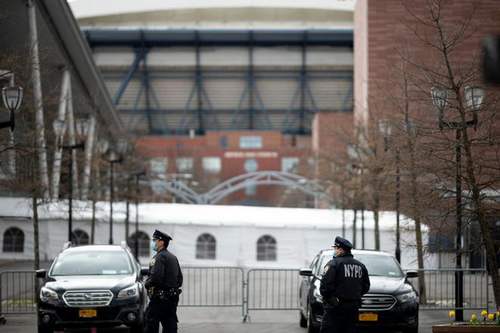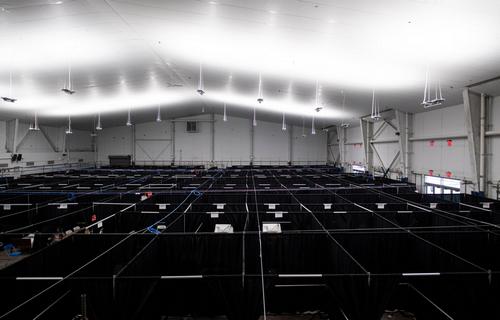The pandemic has presented unique challenges for officials grappling with a fast-moving and largely unpredictable foe.
But the story of the Billie Jean King facility illustrates the missteps made at every level of government in the race to create more hospital capacity in New York. It is a cautionary tale for other states now facing surges in cases and for New Yorkers bracing for a possible second wave.
Doctors at the Queens Hospital Centre, a public hospital in Jamaica, and at other medical centres wanted to transfer patients to Billie Jean King. But they were blocked by bureaucracy, turf battles and communication failures, according to internal documents and interviews with workers.
The Queens Hospital Centre emergency department has a capacity of 60, but on its worst night of the coronavirus pandemic, more than 180 patients lay on stretchers in the observation bays and hallways. Alarms rang incessantly as exhausted doctors rushed from crisis to crisis.
Less than 4 miles away, a temporary hospital opened the next morning, on 10 April. The facility, which was built at the USTA Billie Jean King National Tennis Centre to relieve the city’s overwhelmed hospitals, had hundreds of beds and scores of medical professionals trained to treat virus patients.

But in the entire month that the site remained open, it treated just three patients from the Queens Hospital Centre emergency department, records show. Overall, the field hospital cost more than $52m (£40.9m) and served only 79 patients.
New York paid as much as $732 (£576) an hour for some doctors at Billie Jean King, but the city made them spend hours on paperwork. They were supposed to treat coronavirus patients but they did not accept people with fevers, a hallmark symptom of the virus. Officials said the site would serve critically ill patients, but workers said it opened with only one or two ventilators.

“I basically got paid $2,000 (£1,574) a day to sit on my phone and look at Facebook,” said Katie Capano, a nurse practitioner from Baltimore who worked at Billie Jean King. “We all felt guilty. I felt really ashamed, to be honest.”
As the coronavirus spread in March, the federal government, state leaders, city officials and hospital executives all began creating their own temporary medical facilities, at times competing against each other. Governor Andrew Cuomo’s office oversaw most transfers to the centres, but city officials say the state did not closely coordinate with other players.
The federal government’s biggest contribution, Navy hospital ship USNS Comfort, arrived in New York with great fanfare but initially did not accept coronavirus patients at all, prompting one hospital executive to call it “a joke”.
Even once the Comfort began treating people with Covid-19, the illness caused by the coronavirus, the hospital ship and another overflow facility run by the state, located at the James K Javits Convention Centre, mostly accepted patients transferred from private medical centres, not from the public hospitals that were the most besieged, according to government data.
Billie Jean King, the only emergency hospital built by the city, should have been a success story: it opened at the height of the pandemic, with a full staff eager to treat virus patients.
An aide to the city’s mayor, Bill de Blasio, who helped oversee the site, Jackie Bray, said the city acted quickly to open it but ultimately concluded patients were best treated at existing hospitals, even if they were crowded. She added that she expected the federal government to reimburse the city for the cost of the facility.
Officials with the city and the state said Billie Jean King and other temporary sites treated so few patients because New York’s statewide shutdown curtailed the virus and hospitals expanded their own capacity, reducing the need for extra beds.
“The alternative space was less used than we expected it to be because we broke the curve, thank goodness,” Ms Bray said.
Doctors disagreed.
“The conditions in the emergency room during this crisis were unacceptable and dangerous,” said Dr Timothy Tan, director of clinical operations at the Queens Hospital Centre emergency department. “Knowing what our patients had to endure in an overcrowded emergency department, it’s frustrating how few patients were treated at facilities such as Billie Jean King.”
In past disasters, such as during Hurricane Sandy in 2012, the state created a unified system across multiple agencies to transfer patients between hospitals. That did not happen during the coronavirus pandemic, leaving hospitals in low-income areas overwhelmed.
Instead, with projections forecasting a severe shortage of beds, officials focused on building field hospitals.
The largest facilities opened in Manhattan in late March – the Comfort and the Javits Centre. They treated about 1,400 patients although only about 300 came from public hospitals, data shows.
Hospitals also opened overflow locations, including a Central Park tent hospital that treated 300 patients from Mount Sinai Hospital. The city’s public hospital system created a wing at a nursing home on Roosevelt Island.
Facing a projected shortage of 50,000 beds, federal officials spent more than $320m (£251.8m) to build facilities at two state colleges and the Westchester County Centre, and the city spent about $20m (£15.7m) on a centre at the Brooklyn Cruise Terminal, records show. In the end, reality never neared the dire projections and none of those facilities opened.
Soldiers are seen at the hospital when it first opened though many now say it was not properly utilised by officials (AFP via Getty)
The only makeshift hospital the city opened was at Billie Jean King.
The complex, home of the US Open, is at the site of the 1964 World’s Fair in Flushing Meadow and is one of the largest tennis centres in the world.
Officials put out a call on 18 March, saying they needed a contractor that could open a hospital in seven days and run it. Only one vendor said it could do it: Slsco, a company from Galveston, Texas, best known for helping build part of Donald Trump’s border wall.
Slsco had spent $90,000 (£70,805) annually to lobby New York in recent years and received contracts after Hurricane Sandy, records show. The company referred questions to city officials.
The contract paid Slsco whatever costs it incurred for creating and operating 470 beds for “Covid-positive patients of medium and high acuity” – plus an additional 18 per cent for profit and overhead, the deal said. The final bill is still being tallied: it could top $100m (£78.6m).
“This is a war effort,” Mr de Blasio said in a news conference at the tennis centre in late March, announcing it would open on 7 April. “This facility will be crucial.”
The site opened on 10 April during the grimmest week of the pandemic, with records in statewide hospitalisations and deaths.
The night before, the patients in the Queens Hospital Centre emergency department included 66 who were so sick that they had already been admitted and were waiting for beds, according to a hospital log.
City officials said emergency department patients were inappropriate for Billie Jean King. The site did not have all of the equipment, drugs and services available at a permanent hospital, they said.
Dani Lever, communications director for Mr Cuomo, said the Queens Hospital Centre transferred 11 patients to the Javits Center that night and could have sent more. The state accommodated every transfer request from hospitals, Ms Lever said.
Other nearby hospitals were also in crisis, including Elmhurst Hospital Centre and several small private hospitals.
de Blasio, who one called the temporary site a ‘war effort’, gives a press conference at the hospital (AFP via Getty)
Slsco had recruited hundreds of workers from across the country. It paid most doctors about $600 (£472) an hour, or $900 (£708) for overtime, according to the contract – far more than the typical rates at hospitals. Registered nurses made more than $250 (£196) an hour, as did pharmacists and physician assistants.
But in the early days they spent hours in orientation to learn computer systems, waiting to get fitted for masks and looking for equipment, workers said. They also said they had to complete repetitive paperwork.
“Extreme dysfunction,” Dr Kim Sue said about working there. “Bureaucracy and dysfunction, and all kinds of barriers to serving patients.”
But the biggest barrier was simple: hospitals did not send many patients to Billie Jean King.
The city did not allow ambulances to take 911 calls to Billie Jean King because health officials said they did not trust the facility to triage patients. The site had its own ambulances, but they could not pick up transfers because, according to some workers at the site, hospitals had exclusive agreements with ambulance companies. So doctors had to wait for transfers. Few came.
In interviews, doctors at overwhelmed private hospitals said they were told they could not transfer to Billie Jean King because it was only for patients from public hospitals.
Several doctors at public hospitals said they believed their bosses did not want to transfer because the hospitals in the public system each had their own budgets, and they did not receive revenue from patients they sent away. Some said they were told Billie Jean King could treat only people with extremely mild symptoms.
There were at least 25 medical conditions that disqualified patients from being transferred to Billie Jean King, including “spiking” fevers, a city spokesman acknowledged.
At Billie Jean King, seven workers said in interviews that even with limited ventilators, they could treat most severely ill patients. They said they grew increasingly frustrated to report every day to a sea of empty beds. Several mentioned that three men with mild symptoms died while quarantining at a Manhattan hotel.
“We were sitting on all of these beds with hundreds of people trained to watch over patients exactly like that, and these people died,” said Elizabeth Ianelli, a social worker at the site. “That was preventable.”
City officials said the men were not sick enough for Billie Jean King’s level of care. They said all hospitals could transfer to the site, which had enough ventilators, and said the ambulances did not pick up because they needed to be available in case patients at Billie Jean King deteriorated and needed to be transferred. Nobody was thinking about patient revenue, they said.
“The thing that saved the most lives was to treat them in expanded capacity in the hospitals and bring staff into the hospitals, and that’s what we were focused on,” said Matt Siegler, a senior vice president at the city’s public hospital system which oversaw the site.
Mr Siegler said he could not think of anything the city should have done differently.
On 27 April, the city amended the contract to pay Slsco for only a 100-bed facility for patients with “low to moderate” needs.
It closed on 13 May.



